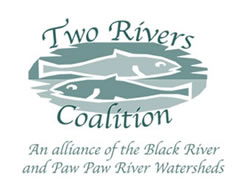19-September-2010, Leg 3
40th Street Bridge to 44th Avenue Bridge
Kevin just got back from a 10 day solo backpacking adventure on Isle Royale where he saw beaver, otter and moose and listened to wolves and loons at night. Reinvigorated by that wilderness experience he resumed his paddling odyssey down the Paw Paw River; his story continues...
I got back to paddling on Sunday, Sep 19. I put in at 40th St Bridge and first went upstream, back to the confluence with the north branch for a second look. Yes, it's still quite lovely and worth the time it took. I then turned around and floated downstream spending several hours in the area west of 40th street. This area is special because it is the least developed part of the entire Paw Paw River flood plain. It sounds very different here - no road noise, nothing but the rustling of leaves from a light breeze, the occasional cackling of a pileated woodpecker, the chattering of squirrels, the splash of turtles abandoning their perch on a log - nature. No houses, no power line right-of-ways, no agricultural fields, just many hundreds of acres of forested wetlands. And these wetlands are doing their job! The river is swollen by a good 18 inches this weekend due to the fact that Maple Lake is being lowered four feet for maintenance at a rate of six inches per day. Even so, the water was still clear. The absence of chocolate brown water means that sediment is not washing into this section of river. Trapping sediment and preventing erosion is one important function of a high quality wetland. At the last Two Rivers Coalition annual meeting we heard about the sediment and erosion problems that exist on the south branch of the river, in part because so much wetland has been lost to farming and other development. TRC, the Van Buren Conservation District and Southwest Michigan Land Conservancy are working together to target the large tracts of forested floodplain that still exist along the main branch, for voluntary conservation efforts by the private landowners.
As I floated the river I noticed the difference in vegetation now that fall is upon us. There was spicebush with its bright red berries which, relished by birds, can be chopped in a spice grinder or blender and used as a seasoning. There is an abundance of paw paw trees with large green fruit that some say is reminiscent of banana custard. The white blossoming turtlehead now dominates the riverbank with only the occasional orange jewelweed and red cardinal flower. A variety of fall fungi grow abundantly on the forest floor. Overhead, large barred owls would silently swoop out of the forest canopy and, occasionally, a turkey would take off into flight from its roost with a tremendous flapping noise. I passed a heron rookery with several large nests still evident in the upper canopy and tried to imagine what it must have been like in the spring time when the nests were full of cacophonous chicks. While I did not see a beaver, freshly chewed trees were evidence of their presence. This part of the river is truly wild and wonderful and very worthwhile visiting.
Normally, this stretch of the river, known to locals as Zululand, would only require about two hours to paddle but I spent about four plus hours on the river today taking time to explore some oxbows. Oxbows are abandoned river meanders where the river, over time, has cut through a bend leaving a non-flowing loop. Some of these oxbows can be clearly seen on the aerial map.
In another few weeks I hope to get to Lawrence and then should have easier paddling where I hope to be able to have other river loving paddlers join me in this celebration of the Paw Paw River. Thanks to those that have made contributions at www.firstgiving.com/kevinhaight in support of this venture. We have already achieved over 25% of the goal!
Regards,
Kevin
If you are a Two Rivers Coalition member or are on our contact list, you will be advised by email when the next leg of the River Odyssey is posted. Sign up to be a TRC member, renew your membership or sign up to receive email updates by becoming a TRC contact.


![Spicebush [Click here to view full size picture] Spicebush [Click here to view full size picture]](media/pages/tn_ppr_pictures_008_spicebush.jpg)
![Paw Paw trees [Click here to view full size picture] Paw Paw trees [Click here to view full size picture]](media/pages/tn_paw_paw_leaves.jpg)
![Paw Paw fruit tastes like bannana custard. Hard to get before the animals do. [Click here to view full size picture] Paw Paw fruit tastes like bannana custard. Hard to get before the animals do. [Click here to view full size picture]](media/pages/tn_paw_paw_fruit.jpg)
![Turtlehead flower [Click here to view full size picture] Turtlehead flower [Click here to view full size picture]](media/pages/tn_ppr_pictures_037_turtle_head.jpg)
![Cardinal flower amongst arrowhead [Click here to view full size picture] Cardinal flower amongst arrowhead [Click here to view full size picture]](media/pages/tn_ppr_pictures_018_arrowhead_and_cardinal_flower.jpg)
![Heron nest very high in the trees [Click here to view full size picture] Heron nest very high in the trees [Click here to view full size picture]](media/pages/tn_ppr_pictures_032_heron_nest.jpg)
![Beaver chew [Click here to view full size picture] Beaver chew [Click here to view full size picture]](media/pages/tn_ppr_pictures_023_fresh_beaver_sign.jpg)
![Fungus among us [Click here to view full size picture] Fungus among us [Click here to view full size picture]](media/pages/tn_ppr_pictures_039_fungi.jpg)
![Hitchhiker. Can you see him? [Click here to view full size picture] Hitchhiker. Can you see him? [Click here to view full size picture]](media/pages/tn_ppr_pictures_013_hitchhiker.jpg)
![Wetland Wonderland [Click here to view full size picture] Wetland Wonderland [Click here to view full size picture]](media/pages/tn_ppr_pictures_040_wetland.jpg)
![Just plain gorgeous! [Click here to view full size picture] Just plain gorgeous! [Click here to view full size picture]](media/pages/tn_ppr_pictures_041_fungi.jpg)